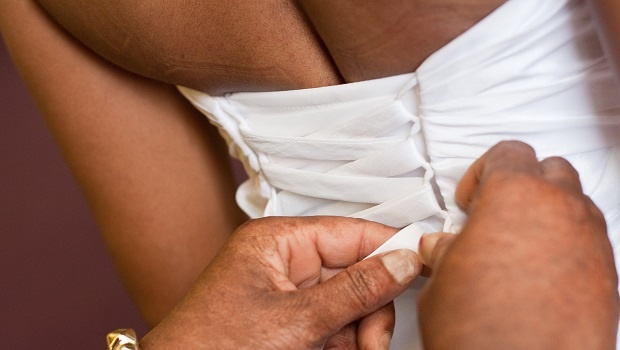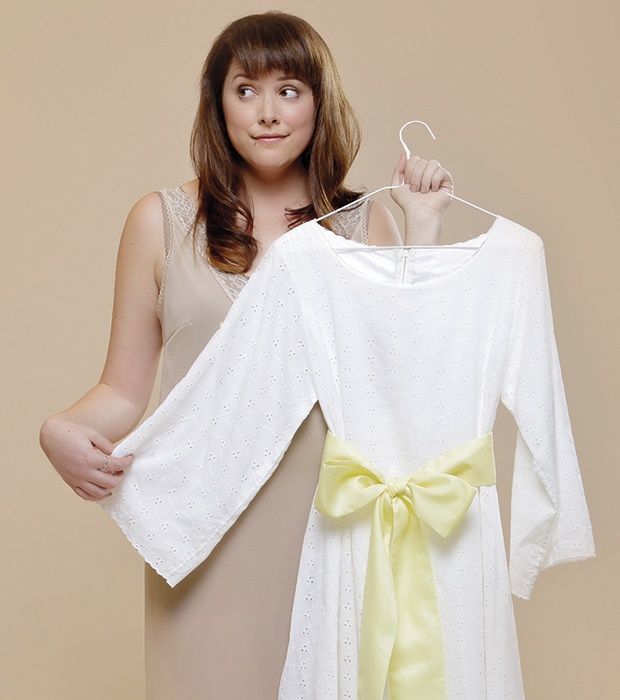
I was getting married in about a year and was on the hunt for that one dress that would make me twirl around like Julie Andrews on a hilltop. As part of my search, I asked my mother if she still had hers. She looked me up and down and said: “It won’t fit you.” She was right. I tried sausaging into it from the top, worming into it from the bottom, but no matter what I tried, I couldn’t manage anything past the knees.
Forty-one years ago, 26-year-old Motshilisi Angoma – Mom, to me – was a black Marilyn Monroe (beauty spot included). On her wedding day, she stood at a dainty 1.56m and wore a size 34 custom-made dress. Her scale rarely made it to 55kg.
Fast-forward to the present, and Motshilisi’s last-born daughter – 30-year-old me – is not only shorter, but a lot curvier. There’s no doubt we share genes: I have her eyes, cheekbones, lack of patience. I don’t need an app to see how I’ll age – I just need to flip through the family photo album. The only thing I didn’t inherit, it seems, was her body shape.
READ MORE: Why does it feel so much harder to lose weight when you’re short?
Looking at pictures of my mom at age 30, I outsize her by more than a few centimetres. And I’m not alone. According to a report in the Proceedings of the National Academy of Sciences journal, women are getting shorter and stouter.
A quick poll of friends and colleagues* supports the science: Susan, who inherited her mom’s willowy figure and long legs and wears a size 30, still can’t fit into her mom’s wedding dress.
Wanita, a slim size 32 – can’t get into her mom’s either. Me – size 36 – no dice. Same DNA, similar shapes, but totally different dimensions. So what exactly is happening in the generation gap?
How our moms ate vs how we eat (eek!)
The culture around activity and food, especially, has evolved across continents to take on less traditional and more Westernised trends. Take my mom and me, for example. Over the years, the African plate has transformed considerably. “We had unprocessed grains such as maize and millet sorghum.
Food was rich in fibre,” recalls my mom. Back then veggies were not a co-star to your meal – morogo (spinach) was the main attraction. Occasionally, meals would include meat. “Red meat, however, was eaten in small quantities. White meat like chicken featured more on our plates,” she says.
And when they ate meat it was the whole animal, including mineral-rich bone (used to make broth) and offal (tripe, liver, kidney and tongue). In her time, food preparation was simple: veggies boiled, chicken salted and boiled – and there was no fast food. In my time, Mr Delivery knows my name – or at least my street name.
I’ve got the Food Hotspots app on my phone, and rather than peel and chop, I remove sleeve and pierce film.
READ MORE: 5 reasons you’re gaining weight that have nothing to do with food
Experts say that in the twenty-first century, my kind of cooking is the norm. There’s a worldwide nutrition transition.
As income levels rise and populations become more urban, we’re faced with myriad food choices. The perplexing paradox is that third-world countries are bearing the brunt of the health issues associated with it.
In the past 30 years, Mexico, for example, has gone from dealing with widespread malnutrition to coping with two-thirds of its population becoming overweight or obese. And one of the main culprits has been the rise in sugar-loaded soft drinks.
In China, rapid transformation of the economy has been mirrored by massive changes in food consumption. For the average Chinese woman, snacking was a rarity not so long ago.
Now it abounds. And in South Africa? “Local today is not that lekker,” says Susanna Kassier, dietician at the University of KwaZulu-Natal who is working on a doctoral study of obesity among urban women in SA. “Traditional foods are viewed as less glamorous and less tasty.”
Exactly what fast-food is doing to our bodies
It’s fast, it’s inexpensive and it delivers a greasy kick that can cure the most debauched hangover. Sixty-four percent of South African adults buy from a fast-food outlet at least once ?a month – and I’m ashamed to say, I contribute to that stat.
There’s no escaping it. Walking down the main road near my house, I’m bombarded by the unholy trinity of temptation – the colonel, the clown and the flaming shield – every hundred metres!
Add the fish-and-chips shop outside my office to the mix, and it’s a wonder I don’t roll to my desk each day. And if my experience is the norm in SA, is it any surprise the fried chicken has come home to roost for all of us South African women are among the fattest in Africa, according to recent research published in The Lancet medical journal.
Their study showed that seven out of 10 South African women are overweight and 42 percent are obese.
They didn’t have muffin tops – say what?!
And the trouble is, it doesn’t stop at your hips: “A diet that contains high amounts of sugar and refined carbohydrates, often found in fast food, causes spikes in blood glucose levels, which results in excess insulin secretion,” explains Claire Julsing Strydom, president of the Association for Dietetics in South Africa.
“This leads to increased abdominal fat storage? and inflammatory response”– better known as the boep, spare tyre, pot belly or, as I call it, paunchiness. But don’t let the cutesy names fool you – abdominal fat (aka visceral fat) is a serious issue that’s been linked to conditions like diabetes and heart disease.
And it’s an issue that Mom didn’t have.“My friends and I weren’t that slim, but we didn’t have the spejeje problems (muffin tops),” she says. Come to think of it, you don’t see those cinched Mad Men waistlines very often these days, and it’s not just about fashion. Look at your own group of 20- or 30-something-year-old friends.
The extra kilojoules in those supersize burgers you’re munching at 3am don’t exactly help you shimmy into skinny jeans.
READ MORE: These are the top 3 diets of 2018, according to health experts
Fast food is by no means the only contributing factor. The processed food trifecta of salt, sugar and oil is another reason for the sharp expansion of our collective girth. These ingredients are more prevalent in our diets today than ever before.
Food companies prey on our biological addiction to the perfect combination of salt, sugar and fat in the same way tobacco companies exploited the addictive properties of nicotine.
These ingredients are responsible for the cravings that have hijacked South African diets, according to Michael Moss, author of Salt Sugar Fat: How The Food Giants Hooked Us. And the most egregious examples are often those we consider the healthiest: skinless grilled chicken coated in a mixture of sugar, fat and salt otherwise known as “marinade”; low-fat products loaded with sugar.
“I remember getting homogenised milk every morning,” my mom reminisces. “I could see the cream. Today, everything is low-fat or fat-free; there’s no nourishment in our food anymore.”
White bread and coca-cola – the dangers…
“Sixty years ago there was less sugar, salt and fat in our food. People ate more foods that resembled their natural state,” says Karen Thomson from the Harmony Food Addiction Clinic in Cape Town. Nowadays, we don’t know what’s in our food.
“Few countries have preserved an attachment to their traditional eating habits. And we are one of the most at-risk obese nations in the world,” says Thomson. “We live on white bread and Coca-Cola. We definitely need to get back to our roots and be more authentic – from the way we behave to the way we eat,” she adds.
READ MORE: Can you eat peanut butter every day and still lose weight?
Back in the day, my mom’s favourite meal was samp and beans. Right off the bat she knew why it was good for her: low in fat and high in protein and soluble fibre, both of which fill you up for a long time on very few kilojoules.
My favourite meal is chicken campagnola: a tasty pasta made with chicken breasts and mushrooms cooked in white wine, garlic, butter and rosemary. I need an app to figure out how many kilojoules and how much fat it contains.“If you want a healthy body and to lose weight for your wedding, just stop relying on people to cook for you [eating in restaurants],” my mom often says.
For her, it’s simple: put the right raw materials in – whole, fresh, unprocessed and chemical-free. Then you won’t have to worry about your body again.
Keyna’s confessions
Tessa, who is in her late fifties, grew up in the Eastern Cape. “We lived in Adelaide. I grew up walking everywhere. It took less than half an hour to walk from one end of the town to the other,” she recalls. “I moved to Graaff-Reinet to study for three years. I used to walk around there too.”
Later, working as a teacher, her day started at 7am and ended at approximately 4.30pm. She was on the go constantly, keeping the kids engaged by leading them in activities and entertaining them, while also running errands and coaching netball. She needed a lot of energy and the ability to work long hours. She got married at 24.
Tessa’s daughter, Keyna, 33, was born and raised in Cape Town. She has a 20-minute drive to work each day. As a graphic designer, she sits at her desk and works on a computer for most of the day, breaking only to engage with clients in sit-down meetings.
After work, she goes to Monday tap lessons and drags herself to Pilates on Wednesdays and Fridays. She’s getting married in just over a year and she, too, can’t fit into her mom’s dress.
The shift in daily physical activity is impossible to ignore when you compare Keyna and her mom’s lifestyles. Keyna’s three-day-a-week exercise schedule fits snuggly in-between weekend series-watching marathons, whereas her mom can hardly sit down for the length of a movie. Our leisure has become effortless; our work has become computerised. And we’re sitting on a time bomb.
READ MORE: 5 best alcohols to drink if you’re trying to lose weight and stay healthy
Sixty percent of adult South African women report that they’re not physically active. In the era of half-price gym specials, personal trainers and crossfit WODs (workouts of the day), it’s ironic that we are less active than our parents were at our age.
And it’s not just us. US researchers conducted a study comparing how people in the Sixties allocated their time during the day and how we do now. They found that back then, UK citizens expended 216 MET hours per week (a measure of physical activity), but by 2005, that number had fallen to just 173 weekly MET hours.
A similar decline was seen in the US, Brazil, India and China, with China’s decline being the sharpest: 399 MET hours in 1991 compared with 213 less than two decades later. And even though there are no similar local stats, Dr Paola Wood, a biokineticist in the Department of Biokinetics, Sport and Leisure Sciences at the University of Pretoria, expects the same trend to be affecting South Africa.
READ MORE: Watch out for these 4 phrases if you want to lose weight
“Many of the previous manual occupations have been replaced with automated devices, resulting in prolonged periods of sedentary behaviour in the workplace and in automobiles,” explains Wood.
“Similarly, a lot of our leisure time involves people spending more and more time in front of screen-based forms of entertainment – watching TV and using computers and gaming consoles,” she says.
“I’d had three children by the time I was in my mid- thirties,” Tessa recalls. “I stopped working to look after the kids and decided that I could also run the household. I woke up around 6am and drove Keyna to school, her younger sister to preschool and entertained the baby at home.”
Tessa didn’t need a personal trainer to help keep excess kilos at bay. “I did all the housework –I didn’t want a domestic helper. I felt I had enough responsibility with three small children and it was also a way to save money. I managed to lose all the weight I had put on during my three pregnancies.”
Are you an “active” couch potato?
Don’t fool yourself. If your waking life is spent sitting at your office desk, shuttling in your car between home-work-lunch-work-home, and you’re already counting down to the next season of Game of Thrones, you’re a couch potato.
Add gym once or twice a week and you’re an active couch potato. “I go to gym but I really enjoy non-active hobbies,” admits Keyna. “Awful, right? I like to crochet and read, and yes – watch TV.
Every now and then I think of taking on another dance class, but I just love being home. My Scrabble scores are getting really high!
”READ MORE: The best way to lose weight when you just love food too much
Constant movement helps limit body-fat accumulation in the hip and butt areas – where women typically store flab. Physiologist Dr Marc Hamilton conducted a study to show how exercise affects an enzyme called lipoprotein lipase (LPL).
LPL’s main responsibility is to break down fat in the bloodstream to be used as energy. If an individual doesn’t have this enzyme, or if their levels are low, the fat is stored instead of being burnt as fuel. Hamilton discovered that when rodents were forced to lie down for most of their waking hours, LPL activity in their leg muscles plummeted.
But when they stood most of the time, the enzyme was 10 times more active. Monday’s tap session gives Keyna her high, and she’s hoping to tap away at her physique to fit into her wedding dress. It’s a step in the right direction.
So, what’s the answer?
The common thread in these stories is that we’re rushing through our lives. Because we’re stretched for time between the office, the 30-minute cardio circuit and the after-work drinks, we don’t take care over preparing our meals. Instead, we rely on the convenience of a microwave to heat our fast food, at the expense of our health.
Plus, we’re so engrossed in our screens that there’s no time to take a walk in the park. Perhaps if we slowed down, we’d carve out time for healthier experiences – and be able to wear any wedding dress we chose. As for me, after 30 years I’ve finally decided to listen to my mom. I’ve quit the campagnola and started dabbling in cardio. And while my scale still mimics a metronome, I’m hoping to catch the beat in time for the wedding march.
Photographs by Igor Polzenhagen
*Apologies to my colleagues for airing their laundry… With the tag sticking out.
Getting married? Or know someone who’s about to walk down the aisle? Check out Shedding For The Wedding – your ultimate guide to torching fat and toning up for the big day.
This article was first published on Women's Health SA.




 Publications
Publications
 Partners
Partners


















